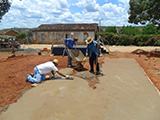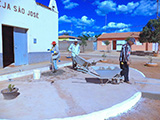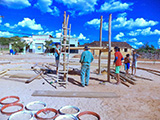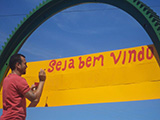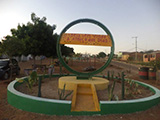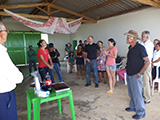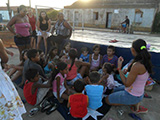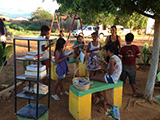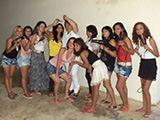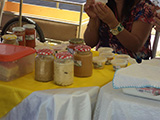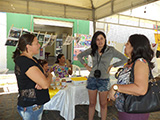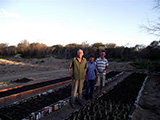
A network in motion
The Social Network of Angico, Peixe and surrounding areas continued to develop and improve existing projects, in addition to discussing and planning future actions. By the end of 2014, the Network featured 26 participants, responsible for projects and initiatives involving about 150 local dwellers to promote improvements in the region.. A survey conducted in the village revealed a 70% level of satisfaction with the initiative.
After the São José square was built, at the end of 2013, the Network continued to mobilize the community to improve and enhance the area, with the support of 58 volunteers – Galvani employees and locals – in this second year of the project.
Moreover, the square also became the stage for storytelling meetings, which started a new project: the “Pro-Reading Campaign”, with weekly meetings that attract about 20 children, in addition to their parents and other adults also enticed by the group’s creativity.
Now children do that every Sunday. If we don’t get there on time, they come after us wherever we are to start the storytelling. As we tell the stories, they interact and really participate.
Jorene Soares Barbosa Rocha, participant in the Pro-Reading projectThe “Ageless Fun” project, is supported by the efforts of about 25 local senior citizens. It increased their attendance in weekly walks and monthly celebrations..
Sometimes, people from other places think we know nothing, that we are a bunch of hillbillies. When I arrived in São Raimundo Nonato to study Social Service, I remember I felt a little excluded. Over time, and with my knowledge from the Network, which has everything to do with what I study, those people realized I was way ahead of them.
Solimar Pereira da Costa, participant in the NetworkLearnings
So that a project for strengthening participatory actions can be effective, its participants must understand its purpose, believe in the results that can be attained, be open, interested and truly engaged with the process.
Local talents start to become social businesses
Also in 2014, the four socioproductive groups created based on the Network’s Income Generation project began a startup-creation process coordinated by the Instituto de Sócio Economia Solidária (ISES), in which business plans were outlined, income generation goals were set and the following names were created:

Technical training sessions were also made available for all the groups: members of Mãos de Fadas were trained on hair cutting and blow-drying by the Embelleze Institute, from Petrolina (Pernambuco); the handicraft group had lessons with educator and designer Paula Dib; members of Doce como o Sertão attended a workshop on jelly, marmalade and fruit preserves, presented by chef Cris Rodrigues; and the agriculture group was trained via EBDA (Bahia’s Company for Agricultural Development), in partnership with the town hall of Campo Alegre de Lourdes/Bahia, where they learned about growing, seeding and irrigation techniques, in addition to attending the PAIS Workshop (Agroecological Integrated and Sustainable Production), presented by the SEBRAE from Juazeiro (Bahia). SEBRAE also partnered with the Network and offered design workshops and sessions about associations/associative networks. A total of 100 participants took part in the workshops, with 186 hours of training. All groups started to produce and/or render services to the local community..
And in order to celebrate the Network’s third anniversary, the LGI sponsored an event with over 300 attendants to present the groups, exhibit their products and photos, a parade by Flor do Sertão, cakes made by the sweet group, music and dance performances and placement of a sign at São José square, with the names of all the participants.
Despite all my experience in this sector, I’ve never seen a community with such a great potential as Angico dos Dias, which seems stronger, united and interested in the development of Income Generation groups
Yuri Ongaro, ISES consultantI’ve been in Flor do Sertão for a year. And I always tell my niece: ‘I was always ill before I joined the group, but now I don’t have the time to fall ill anymore
Member of the Flor do Sertão groupNext steps
To begin the second cycle of the project and strengthen the startup process of socioproductive businesses, with closer integration among the groups, assessment of the income and productive potential of each ongoing project, definition of work strategies and continuous pursuit of partners that promote the entrepreneurship.
Actions and projects that deserve special communication
In order to raise awareness about the Network, its projects and most popular actions, we created the Communication Center. The center is comprised of a group of young volunteers that created and managed the following channels: the Mural newspaper, which was named as Diário da Rede and the Network’s fanpage on Facebook, which had 230 fans by the end of the year, 40% of which are locals..
The Network also gained a logo, created by its members, who chose a typical hamper as the key element to represent them. In addition to being a typical local object, it is remembered and celebrated at each meeting as a symbol of their union: “The lesson the hamper teaches us is how strong union can be”. Volunteer Takashi Siqueira Rubem de Macedo was in charge of translating the main ideas and concepts brought up by the Network into a single picture.
Learnings
The communication must be strengthened so as to inspire greater credibility and participation. However, we should avoid recommending a product to be addressed and leave this choice totally up to the community, respecting their local limits, talents and interests.
